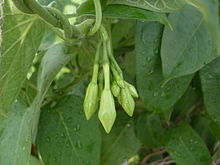How to Incorporate Loroco into Traditional Dishes
Loroco a unique and aromatic edible flower native to Central America, is gaining popularity in kitchens worldwide due to its distinct flavor and versatile nature. This flower, primarily used in countries like El Salvador, Honduras, and Guatemala, adds an earthy, slightly bitter taste with a hint of floral notes. It’s commonly used to enhance a variety of traditional dishes, from tamales and pupusas to soups and stews.
For anyone looking to elevate their culinary creations, incorporating Loroco into traditional dishes can be a fun and flavorful challenge. Whether you’re an experienced cook or just starting to experiment with Central American cuisine, Loroco offers a wonderful way to bring a fresh twist to classic recipes. This article will explore several creative ways to incorporate Loroco into traditional dishes and provide practical tips on how to make the most of this unique ingredient.
Understanding Loroco
Before diving into how to incorporate Loroco into traditional dishes, it’s important to understand what Loroco is and why it’s so special. Loroco is a flowering vine, known scientifically as Fernaldia pandurata, which produces small, green buds. These buds are typically harvested before they bloom and are either used fresh or preserved in brine. Loroco’s distinctive flavor profile sets it apart from other herbs and vegetables commonly used in cooking. The flower buds have a delicate texture with a sharp, savory taste that can complement both mild and bold flavors. While Loroco can sometimes be difficult to find fresh outside of Central America, it’s often available in jars or as a paste in specialty stores, making it easier to incorporate into your cooking.
Incorporating Loroco into Tamales
Tamales are a traditional dish that can benefit greatly from the addition of Loroco. Typically made by wrapping masa (corn dough) around a filling of meat, cheese, or vegetables, tamales can be easily enhanced with Loro-co. One simple way to incorporate Loro-co is by mixing chopped fresh or preserved Loro-co buds into the masa dough. The flower’s flavor will infuse the masa, offering a subtle yet aromatic taste that complements the other ingredients. Loro-co can also be added directly to the filling, pairing well with cheese or chicken. Adding Loro-co to tamales offers a unique variation of a beloved traditional dish, making it perfect for gatherings or special occasions.
Loroco in Pupusas
Pupusas, another iconic dish from El Salvador, are thick corn tortillas filled with various ingredients like cheese, beans, and meats. Loroco is one of the most popular fillings for pupusas, and it adds a vibrant flavor to the dish. To make pupusas with Loro-co, simply incorporate Loroco into the cheese filling. You can mix fresh or preserved Loro-co with a soft cheese such as queso fresco or mozzarella. When cooking the pupusas on a griddle, the cheese will melt, creating a creamy texture that complements the slightly bitter taste of the Loro-co. This combination is beloved in Central American cuisine and is sure to impress anyone who tries it.
Loroco in Soups and Stews
Soups and stews are ideal dishes for incorporating Loroco because the flower’s flavor can easily infuse into the broth. Whether you’re preparing a rich chicken soup, a hearty vegetable stew, or a savory beef broth, Loro-co can be added as a flavorful garnish or a key ingredient in the dish. To incorporate Loro-co into soups or stews, it is best to add it toward the end of the cooking process to retain its delicate flavor. Fresh Loro-co can be chopped and stirred into the pot, while preserved Loro-co can be added directly from the jar. In addition to its flavor, Loro-co also adds a pop of color to the dish, making it visually appealing.
Loroco in Salsas
Salsas are a staple in many traditional Central American dishes, and Loro-co can easily be used to elevate the flavor of your salsa. By blending fresh or preserved Loro-co with tomatoes, onions, cilantro, and other typical salsa ingredients, you can create a unique, flavorful accompaniment for tacos, grilled meats, or other dishes. Loro-co’s floral and savory notes blend well with the tangy acidity of tomatoes and the heat from peppers, creating a balanced and vibrant salsa. It’s an easy way to incorporate Loro-co into your meal and introduce a new taste experience to familiar dishes.
Loroco in Rice and Beans
Rice and beans are a fundamental part of many Central American meals, and Loro-co can be used to add a unique twist to this classic combination. You can stir chopped Loro-co into rice or mix it into beans during cooking to infuse the dish with a subtle floral and earthy flavor. Loro-co works particularly well with black beans or red beans, providing a nice contrast to the richness of the beans. For rice, you can mix Loro-co with the cooked rice, adding it just before serving to preserve its flavor and color. This simple addition will elevate a basic meal into something extraordinary, showcasing Loro-co’s versatility in everyday cooking.
Loroco in Grilled Meats and Fish
Grilled meats and fish are a perfect match for the vibrant and aromatic flavor of Loro-co. The flower can be used in marinades or as a topping for grilled proteins, adding an unexpected twist to your typical barbecue or grill session. To make a marinade, blend Loro-co with olive oil, garlic, lime juice, and herbs. The marinade can be applied to chicken, beef, or fish before grilling, allowing the Loro-co to infuse the meat with its unique flavor. Alternatively, you can sprinkle fresh chopped Loro-co over grilled meats as a garnish, providing a burst of color and flavor.
Loroco in Breakfast Dishes
Incorporating Loroco into breakfast dishes is a great way to start the day with a new flavor profile. You can add Loro-co to scrambled eggs or omelets, where its savory and slightly bitter taste complements the richness of the eggs. For a more substantial breakfast, consider adding Loro-co to breakfast burritos or tostadas. Mixing Loro-co with cheese, beans, or avocado creates a satisfying and flavorful filling. Loro-co also pairs well with breakfast meats like bacon or sausage, adding depth to the dish. This is an easy and delicious way to enjoy Loro-co in a variety of morning meals.
Tips for Cooking with Loroco
When incorporating Loroco into traditional dishes, there are a few key tips to keep in mind to ensure the best results. First, consider the form of Loroco you’re using—whether fresh, preserved in brine, or in paste form. Fresh Loro will have a more vibrant flavor, while preserved Loroco offers convenience and a more concentrated taste. If you’re using preserved Loro, be sure to rinse it well to remove excess salt from the brine. Second, start with small amounts, especially if you’re new to cooking with Loro, as its flavor can be strong. You can always add more if needed, but it’s better to start conservatively and build up the flavor. Finally, Loro pairs well with a wide range of ingredients, so feel free to get creative. Its subtle bitterness works well with rich, savory foods like cheese, meats, and beans, as well as with tangy or acidic ingredients like tomatoes and citrus.
Conclusion
Incorporating Loroco into traditional dishes is a wonderful way to explore the flavors of Central American cuisine and add a unique touch to your meals. Whether you’re using it in tamales, pupusas, soups, salsas, or rice dishes, Loro brings an earthy, floral flavor that enhances the overall dish. By experimenting with different ways to use this distinctive ingredient, you can create exciting and flavorful meals that reflect the richness of Central American culinary traditions. So next time you’re in the kitchen, consider reaching for Loroco to elevate your cooking and bring a taste of Central America to your table.





